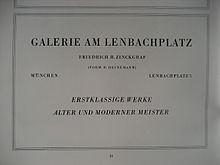Heinemann Gallery
The Heinemann Gallery was founded in 1872 by the painter David Heinemann (1819–1902) as Heinemann'sche Kunsthandlung in Munich .
The gallery until 1933
Originally the gallery rooms were on Promenadeplatz , later they were moved to Prinzregentenstraße, and from 1904 to Lenbachplatz . The flourishing company had branches in Frankfurt am Main, Nice and New York, among others. The Heinemann Gallery devoted numerous exhibitions to the art of the 19th century and French painting. It was one of the most important German art dealers with extensive international relationships and an excellent reputation. From 1890 the three sons of the art dealer Heinemann took over the business: Hermann (1857–1920) managed the Munich parent company, the eldest brother Theodor (1855–1933) headed the New York branch, Theobald (1860–1929) the branch in Nice.
The gallery during the National Socialism
After Theobald's death in 1929, the latter's widow, Franziska Heinemann (1882–1940), daughter of Joseph Schülein , took over the gallery together with her son Fritz (1905–1983) until it was expropriated at the end of 1938. The final “Aryanization” took place at the end 1939. Fritz Heinemann had already emigrated to Switzerland in January 1938 and left the company as a partner. After some negotiations, his share was taken over by Friedrich Heinrich Zinckgraf (1878–1954), an employee of the gallery, at the end of 1939 . After the pogroms on 9/10 In November 1938 Franziska Heinemann was sent to the Stadelheim prison by the Gestapo. She was supposed to cede her art possessions and sell all her property to finance her emigration. In this predicament, she had to accept a very unfair offer from Zinckgraf to take over the property. Zinckgraf offered little more than the purchase price for the painting collection, a value that was 60% below market prices. For the gallery house he offered 20% below the unit value and thus a price considerably below the market price. With the help of a large loan of 275,000 Reichsmarks from his friend Hjalmar Schacht , Zinckgraf was able to carry out this Aryanization at the end of 1939.

He was the official owner of the gallery. Schacht had also reserved the position of silent partner as security for the high credit and participated in the gallery's future profits with a share of 40%. These gains were enormous. Once because of the low purchase price of the pictures. The art market also boomed, as many investors bought works of art as an investment during the war. Schacht - and of course Zinckgraf too - had closed the most profitable business of his life with this participation . Franziska Heinemann managed to reach the safe foreign countries. She died on November 17, 1940 in New York.
After 1945
Her son Fritz returned to Munich after 1945 and was active as an art dealer again. In 1972 he handed over the gallery's business documents to the German Art Archive in the Germanisches Nationalmuseum , Nuremberg. These were put online by the museum in 2010.
literature
- Birgit Jooss : Galerie Heinemann. The checkered history of a Jewish art dealer between 1872 and 1938 . In: G. Ulrich Großmann (Ed.): Anzeiger des Germanisches Nationalmuseums . Nürnberg 2012, pp. 69-84 ( online ).
Individual evidence
- ↑ Christopher Kopper : s. Hjalmar shaft. The rise and fall of Hitler's most powerful banker. Munich 2006, ISBN 3-446-40700-6 , page 289f
- ↑ Christopher Kopper: s. Hjalmar shaft. The rise and fall of Hitler's most powerful banker. Munich 2006, ISBN 3-446-40700-6 , page 291